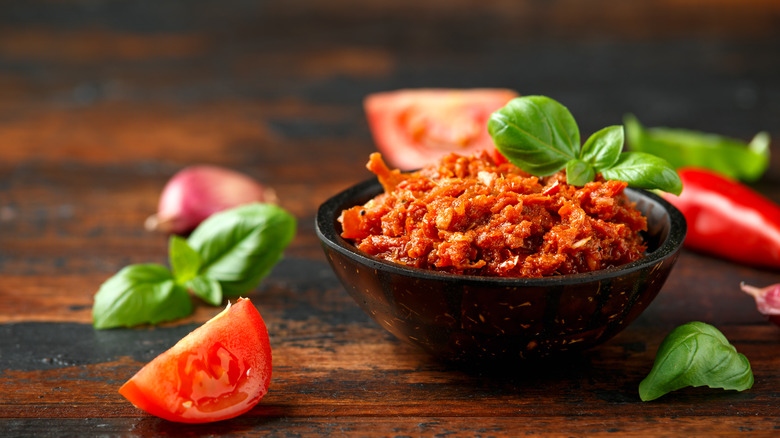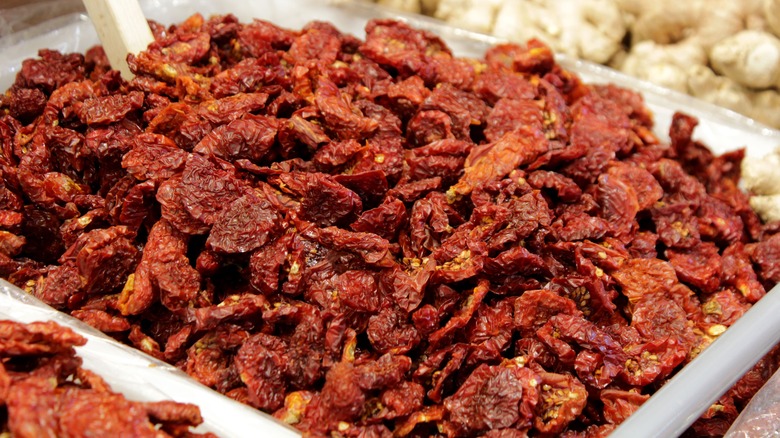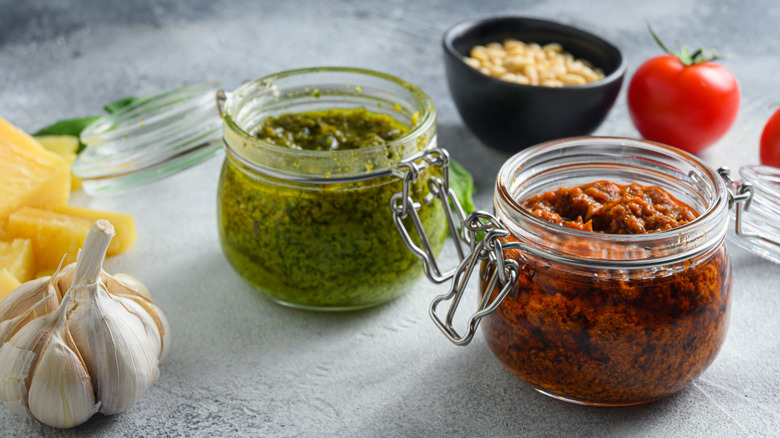Pesto Rosso: The Umami-Rich Take On An Italian Classic
The green alternative to any marinara, Bolognese, or amatriciana sauce, pesto is its own entity entirely. The herbaceous sauce can transform even the blandest of pastas, adding an olive oil drizzle, a pine nut crunch, and, of course, a Parmesan flavor.
Despite the intensity of its taste, pesto is incredibly simple to make. According to Insider, it originated in Genoa, Italy, and consists of seven main ingredients: basil, extra-virgin olive oil, pine nuts, Parmesan and pecorino cheeses, salt, and garlic. While pesto's simplicity can easily be replicated outside of Italy, Genoa's version is especially flavorful, thanks to the quality of Italian ingredients. For instance, Genovese basil has smaller leaves and a more delicate taste.
While basil is responsible for a portion of pesto's taste and vibrancy, the sauce doesn't have to be Grinch-like in shade to count as pesto. One pesto that differs in color is pesto rosso. It's known for a deep red hue — and a flavor that encroaches on tomato territory.
Pesto rosso replaces basil with sun-dried tomatoes
While traditional pestos rely on basil, the herb can be easily substituted — and that doesn't mean downgrading your pesto. Pesto rosso, which translates to red pesto, calls for sun-dried tomatoes in addition to standard ingredients like pine nuts, pecorino or Parmesan, olive oil, and garlic (via MasterClass).
To make your own pesto rosso, you can use a food processor or mortar and pestle, just like you would for the original version. The end result for either apparatus is fairly similar, though MasterClass suggests using a food processor if you're short on time. From there, you can choose how much to blend your pesto. If you're planning to use the pesto as a spread, you may want to blend longer for a smoother consistency. If you're hoping to spruce up plain pasta, keep the larger chunks of sun-dried tomatoes for added texture.
Likewise, pine nuts are another ingredient that leaves room for interpretation and variation. To enrich flavor, toast pine nuts prior to blending them (per MasterClass). If you're pressed for time, however, you can forgo the toasting — or consider substituting pine nuts with other nuts or seeds. According to Insider, pine nuts are among the world's most expensive nuts, so you can swap them out for a more affordable alternative like pumpkin or sunflower seeds.
Pesto rosso can add flavor to a variety of dishes
You can use pesto rosso the same way you would traditional pesto. Both red and green pestos typically pair best with pasta — a blank canvas that leaves plenty of room for experimentation. Per Food Network, pesto pasta can take any number of turns. You can boil your favorite pasta shape and add your choice of protein, cheese, and vegetable. Finish off the dish with a spoonful of pesto rosso, and you'll upgrade a standard weeknight dinner to a main course meal.
However, just because pesto is often paired with pasta doesn't mean it's reduced to that single use. Pesto rosso is as much a condiment as it is a sauce, and can be used in a multitude of ways. Trader Joe's recommends spooning pesto rosso atop a toasted baguette or a do-it-yourself pizza. If you'd rather incorporate pesto into your food than atop it, try easing some into your next batch of soup. It works particularly well in minestrone.
According to Eataly, pesto also pairs well with cheeses and vegetables. The next time you make potato salad, try making an Italian variation that uses pesto rosso as a base instead of mayonnaise. Pesto rosso is also a welcome addition to a Caprese salad. If you're looking to pair pesto with a carb that isn't pasta or pizza, consider adding it to a piece of focaccia. What's a better lunch than a focaccia sandwich smeared with pesto — red or green?
What are the different uses for pesto rosso and pesto Genovese?
While pesto Genovese and pesto rosso both fall under the pesto umbrella — and are used with similar foods — they have completely different flavors and therefore serve completely different purposes. Pesto rosso hovers somewhere between pesto Genovese and traditional red tomato sauce. Compared to standard tomato sauces, however, pesto rosso offers a more intense, slightly sweeter flavor. This change is due to the addition of sun-dried tomatoes, as well as traditional pesto ingredients. According to MasterClass, sun-dried tomatoes are "sweet, tangy, and chewy." They're especially useful in spreads — like, of course, pesto. As such, opt for pesto rosso over pesto Genovese whenever you're craving the consistency of pesto with the oomph of tomato.
Yet to truly understand the differences between these two pestos, it's probably best to try them for yourself. Not only will a spoonful of your preference add flavor to any pasta, but it will also add a pop of color. You get to decide whether that pop leans green or red.



